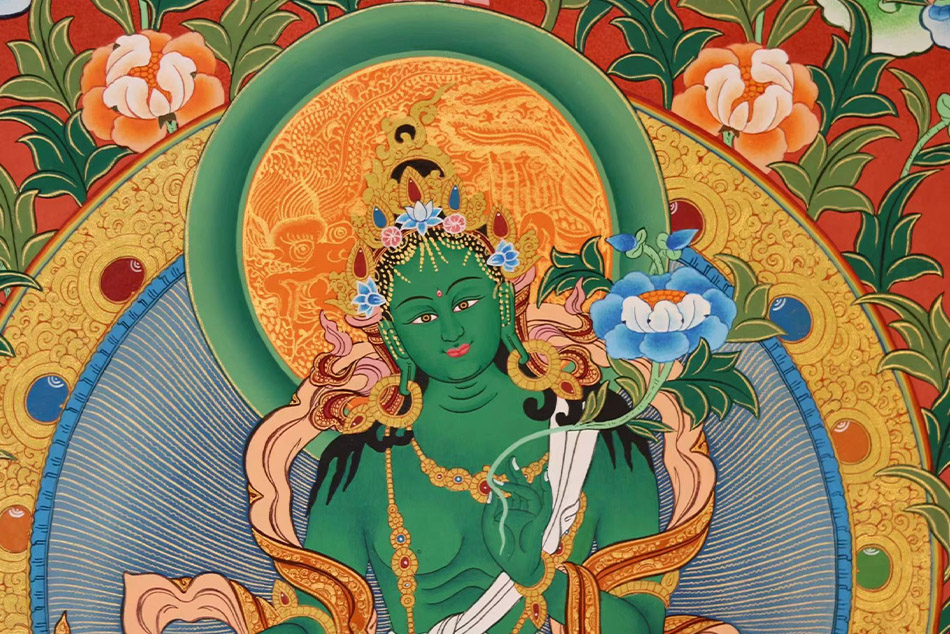Vaidurya is a gemstone with diverse interpretations and applications across religious, medicinal, and astrological contexts. It is commonly known as cat's eye (chrysoberyl) as it resembles a shimmering line of a cat’s eye. The shimmering is caused by the reflection of light. This phenomenon is known as chatoyancy effect. Vaidurya is also called by different names in different traditions: for example, beryl, lapis lazuli, and aquamarine. As opposed to vaidurya, which is considered to have a radiant quality, emitting sparkling light (vaidurya prabha), lapis lazuli is an opaque stone. The color ranges from greenish-yellow to brown, with high-quality stones being heavy, bright, and free of impurities. In Ayurveda, vaidurya is considered to be blue sapphire.
According to Ayurveda and Rasashastra (alchemy), vaidurya has healing properties and is used to treat bleeding disorders, alleviates pitta-related imbalances, improves digestion, and enhances intellect. Likewise, in Tibetan and Chinese Buddhist tradition, lapis lazuli or beryl is highly esteemed as a symbol of purity and, according to the White Lotus Sutra, it is said that vaidurya is one of the relics of the buddhas. Hence, although the term lapis lazuli and vaidurya might not seem to have a directly concurrent meaning, they are used interchangeably due to the symbolic association between them.
Vaidurya can have several colors, but when it refers to the Medicine Buddha (Tib.: Sangye Menla; Sanskrit: Bhaisajyaguru Vaiduryaprabha Raja, "King of Lapis Lazuli Radiance"), as in the Buddha of Medicine dharani, it is blue or aquamarine. The most famous medical text in Tibetan tradition is called the "Blue Beryl" (Vaidurya sngon po, མཆོག་སྤྲུལ་སྔོན་པོ་), written by Desi Sangye Gyatso in the 17th century. The title refers to the blue vaidurya as a symbol of clear insight and wisdom in healing. This text is an extensive commentary on the Four Tantras (Gyüshi), the root texts of Tibetan medicine.
Vaidurya is also one of the mineral formulations used for making rinchen ribu (precious pill). The stone is ground into fine powder and combined with herbs and other minerals. The mixture undergoes a complex alchemical process, which results into round spherical pills. These pills are prescribed for various ailments. Some health benefits of these pills include reduction of inflammation, mental clarity, and improvement in eye-sights. These pills also balance the energies (nyepa), specially, wind energy (rlung) and has calming and stabilizing effects. Tibetan physicians often chant Medicine Buddha mantras over herbal concoctions or water to "charge" them with healing energy. The mantra "Tayata Om Bekanze Bekanze..." is believed to amplify the efficacy of treatments. Iconographically, the Medicine Buddha is portrayed as holding a myrobalan plant (Terminalia chebula) in his right hand and a lapis lazuli-colored medicine bowl in his left. These symbols represent vaidurya’s role in curing diseases and purifying karma through meditation and mantra recitation.
The connection between vaidurya and its spiritual healing aspect is mentioned in a foundational Mahayana text Bhaisajyaguru Sutra, or Bhaiṣajya-guru-vaiḍūrya-prabhārāja Sūtra. The sutra likely originated in Gandhara (modern-day Pakistan/Afghanistan), with Sanskrit manuscripts dating to the 7th century CE found at Bamiyan. This text has also been translated into Chinese and Tibetan. The Tibetan Kangyur contains both long and short recensions, with rituals composed by scholars like Shantarakshita. This text describes the teachings and vows of Bhaisajyaguru who embodies healing and compassion. The sutra emphasizes liberation from physical and mental suffering, offering both spiritual and practical solutions to illness, poverty, and adversity. It combines metaphysical teachings with tangible practices for healing and well-being.
Bhaisajyaguru’s Twelve Great Vows is a compilation of his commitment to alleviating suffering and guiding beings toward enlightenment. These vows form the ethical and doctrinal backbone of the sutra. The vows reflect Bhaisajyaguru’s aspirations as a bodhisattva before attaining Buddhahood. For example, a few notable vows of Bhaisajyaguru are:
- Ensuring all beings attain health and freedom from mental and physical afflictions
- Providing material needs and protection from disasters, which brings relief from poverty and suffering
- Leading those astray back to the Dharma path and guiding them to Enlightenment
- Preventing violent or untimely death
The sutra prescribes three primary practices:
- Invoking Bhaisajyaguru’s name to purify karma and cultivate compassion, which is done by recitation of the Buddha’s name
- Reciting the mantras and dharanis such as "Tadyatha Om Bhaisajye Bhaisajye Maha Bhaisajya Samudgate Svaha", over water, medicine, or food to empower healing. Chanting the mantra 108 times over water creates "blessed water", which generates a healing effect.
- Meditating on the Medicine Buddha’s lapis lazuli radiance, which is often accompanied by offerings to the Sangha or sutra transcription
In conclusion, although Vaidurya is generally understood as gemstone, it transcends its identity, particularly in Tibetan medicine, symbolizing a synthesis of spiritual insight and empirical healing. From the radiant aura of the Medicine Buddha to the structured wisdom of the Blue Beryl, it represents interconnection between spiritual and practical therapeutics. It continues to inspire both traditional practitioners and modern holistic approaches to health.
